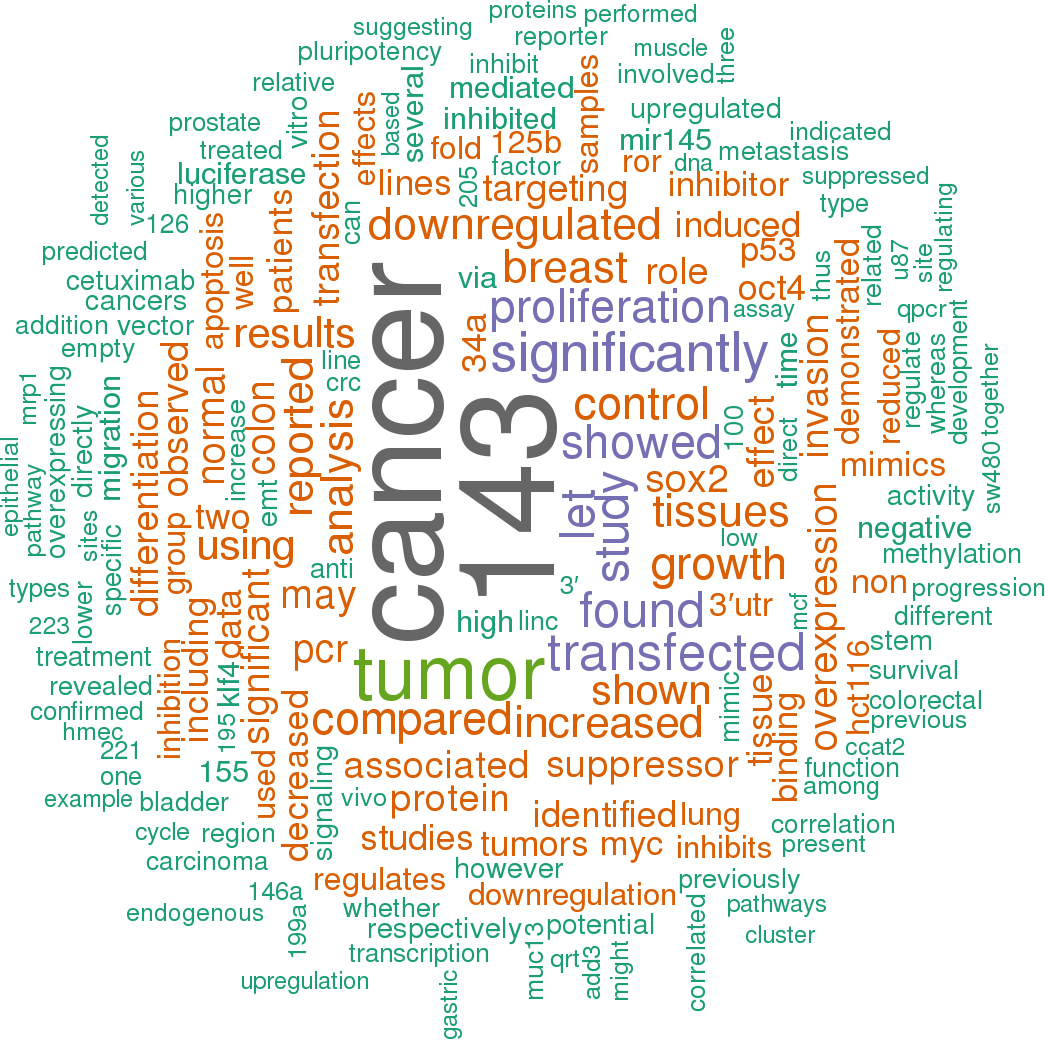Accession
MI0000461
Symbol
HGNC:
MIR145
Description
Homo sapiens
hsa-mir-145 precursor miRNA mir-145
Gene
family?
family?
RF00675;
mir-145
Summary
Caution, this is an AI generated summary based on literature. This may have errors. ?
MIR145, a microRNA transcribed alongside miR143 from a single precursor molecule, plays a role in regulating stem cell pluripotency [PMC7956570]. It has been observed that in diabetic nephropathy (DN) patients, MIR145 levels are significantly elevated in urinary extracellular vesicles (uEVs) and increase further with the onset of proteinuria [PMC9603196]. In mouse models, the loss of the transcription factor Sox2 has been linked to an increase in MIR145 levels, which subsequently leads to a decrease in Sox9 protein levels [PMC3865748]. In the context of cancer, MIR145 has been implicated in epigenetic alterations such as promoter hypermethylation in pituitary tumors [PMC7281098], and it has been included as part of a logistic regression model that effectively distinguishes non-small cell lung cancer (NSCLC) patients from controls with high sensitivity and specificity [PMC6463117]. Additionally, MIR145 upregulation has been documented in the blood of idiopathic pulmonary arterial hypertension (IPAH) patients, suggesting its significant role in disease pathophysiology [PMC4357130]. Furthermore, miRNA-145's host gene is identified as ENSG00000269936 and is considered a potential biomarker for breast cancer diagnosis [PMC6786248], while its therapeutic potential is highlighted by its inclusion alongside other tumor suppressor miRs to inhibit colon cancer tumorigenesis upon oral administration in mice models [PMC7147085].
Literature search

668 open access papers mention hsa-mir-145
(4250 sentences)
(4250 sentences)
Sequence
1428616
reads,
13141
reads per million, 150 experiments
caccuuguccucacgGUCCAGUUUUCCCAGGAAUCCCUuagaugcuaagauggGGAUUCCUGGAAAUACUGUUCUugaggucaugguu
.(((.((.(((((.((..((((.((.((((((((((((.............)))))))))))).)).))))..))))))).)).))).
.(((.((.(((((.((..((((.((.((((((((((((.............)))))))))))).)).))))..))))))).)).))).
Structure
c u u c UC U C uagau acc ug ccuca gG CAGU UU CCAGGAAUCCCU g ||| || ||||| || |||| || |||||||||||| c ugg ac ggagu UC GUCA AA GGUCCUUAGGgg u u u u - UU U A uagaa
Annotation confidence
High
Do you think this miRNA is real?
Comments
This miRNA sequence was predicted based on homology to a verified miRNA from mouse [1]. Michael et al. subsequently verified expression of miR-145 in human, and demonstrated significantly reduced levels of the miRNA in precancerous and neoplastic colorectal tissue [2]. The mature sequence shown here represents the most commonly cloned form from large-scale cloning studies [4].
Genome context
chr5: 149430646-149430733 [+]
Clustered miRNAs
1 other miRNA is < 10 kb from hsa-mir-145
| Name | Accession | Chromosome | Start | End | Strand | Confidence |
|---|
Disease association
hsa-mir-145 is associated with one or more human diseases in the Human microRNA Disease Database
| Disease | Description | Category | PubMed ID |
|---|
Biological pathways
hsa-mir-145 is involved in one or more biological pathways:
(Source: Reactome)
(Source: Reactome)
Biological reactions
hsa-mir-145 is involved in one or more regulation/signalling events:
(Source: Reactome)
(Source: Reactome)
Mature hsa-miR-145-5p
| Accession | MIMAT0000437 |
| Description | Homo sapiens hsa-miR-145-5p mature miRNA |
| Sequence | 16 - GUCCAGUUUUCCCAGGAAUCCCU - 38 |
| Evidence |
experimental
cloned [2-4] |
| Database links |



|
| Predicted targets |



|
Mature hsa-miR-145-3p
| Accession | MIMAT0004601 |
| Description | Homo sapiens hsa-miR-145-3p mature miRNA |
| Sequence | 54 - GGAUUCCUGGAAAUACUGUUCU - 75 |
| Evidence |
experimental
cloned [4] |
| Database links |



|
| Predicted targets |



|
References
|




